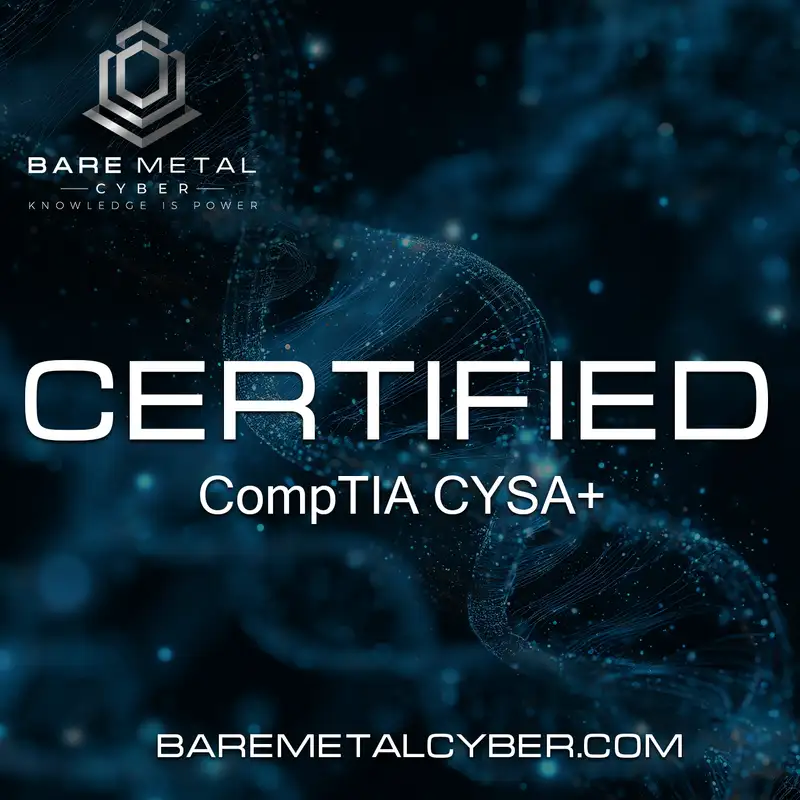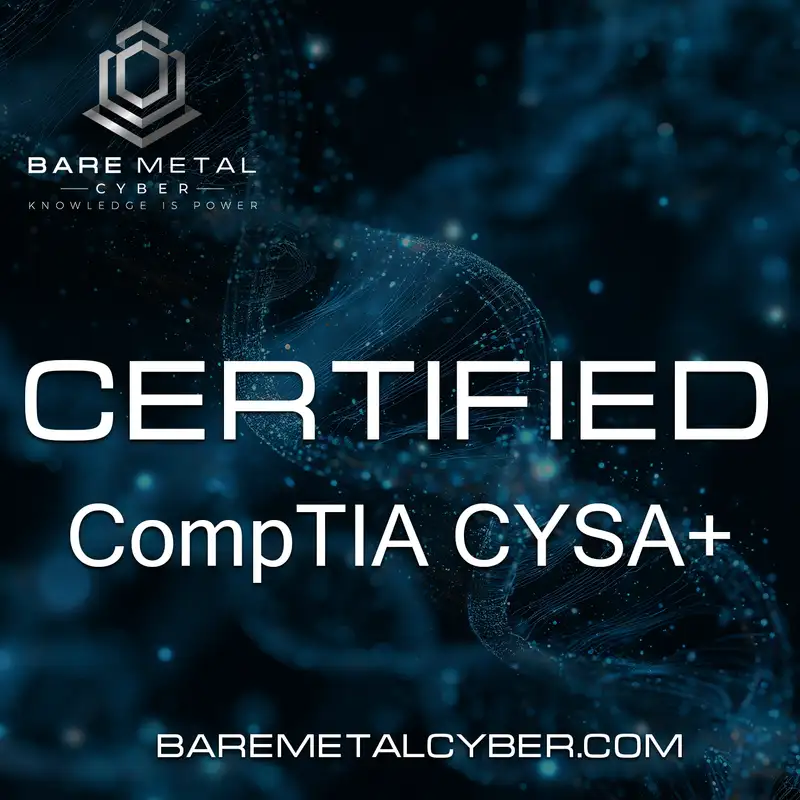Episode 4: How to Study for the CYSA Plus — Tools, Labs, and Habits
Welcome back to Episode Four of your CYSA Plus Prep cast. In today’s session, we’ll break down a strategic approach to preparing for the exam—one that includes study planning, lab configuration, and daily discipline. We’re not just going to talk about books and resources. We’ll dive into habits that sharpen your technical judgment, tools that give you practical exposure, and routines that help you retain complex cybersecurity concepts. Whether you're studying solo or as part of a group, understanding how to structure your learning experience is the first step toward mastering this certification.
Before we dive into the techniques and resources themselves, it’s important to understand why studying for this particular exam requires more than just reading. The CYSA Plus certification is designed to evaluate your ability to detect, analyze, and respond to security threats in practical environments. This means you’ll need more than passive knowledge—you’ll need analytical thinking and hands-on familiarity with tools and procedures. Theory alone won’t get you across the finish line. If you’re not spending time in simulated environments working through real tasks, you’re only preparing for part of what the exam demands.
A strong exam preparation strategy starts with foundational materials. Your first stop should be a comprehensive CYSA Plus study guide, preferably one aligned directly with the current version of the exam objectives. From there, integrate official practice questions and explore interactive tools like digital flashcards. These resources help reinforce terms, concepts, and process logic in short, repetitive bursts, improving retention over time. Flashcards and question banks are particularly effective for quick review sessions and for identifying weak points in your knowledge.
Official CompTIA materials—including the CYSA Plus CertMaster series—offer structured, exam-aligned preparation content. These are trusted resources because they come directly from the exam creators and offer scenario-based learning, timed questions, and concept reinforcement tailored to the exam blueprint. CompTIA also includes performance-based items in its training platform, which is essential for preparing for the practical questions you’ll encounter during the test. When used consistently, these tools become a reliable way to simulate exam day expectations and build confidence.
Complement your official materials with credible third-party content. Well-known cybersecurity textbooks and blogs often present concepts from a different perspective, giving you additional angles to consider as you study. Video training platforms can also be helpful for visual learners, especially those that demonstrate real-time lab configurations, log analysis, or tool usage. These supplemental resources give you depth of understanding and often expose you to practical applications that help bridge the gap between textbook knowledge and field-level execution.
Study efficiency comes from structure. That means creating a well-defined study schedule, broken into realistic, manageable blocks. Divide your time by exam domains, assign each section a weekly target, and leave room for review and lab work. Avoid marathon study sessions and instead aim for consistent, focused blocks each day. For example, a dedicated sixty-minute block five days a week will lead to better retention and less burnout than trying to cram everything into a weekend. Structured repetition is how concepts stick and skills develop.
Speaking of daily structure, the habits you develop during study prep are just as important as the tools you use. Regular study routines, ideally held at the same time each day, allow your brain to adapt and anticipate focused learning. This makes it easier to enter a state of deep concentration. Avoid distractions during your study window—turn off notifications, use noise-canceling headphones, and give yourself the space to focus. These simple discipline strategies can drastically improve the quality of your preparation over time.
Beyond repetition and routine, reinforcement is key. One of the best ways to reinforce what you learn is by summarizing concepts out loud or in written form immediately after studying. This forces you to translate passive information into active understanding. If you can explain a process clearly and accurately to someone else—or to yourself—you’ve successfully internalized it. Regularly reviewing your summaries also keeps older material fresh, reinforcing memory consolidation and promoting long-term retention.
Group study can also be incredibly effective when used strategically. Explaining concepts to others, listening to different interpretations of the same topic, or discussing hands-on labs as a team all deepen understanding. Group settings allow you to uncover blind spots, discover new study resources, and gain motivation through accountability. The key is to remain focused—use group time for structured discussions, lab reviews, or practice test comparisons, not as a substitute for independent learning.
Another memory-enhancing strategy is spaced repetition. This technique involves reviewing older material at increasing intervals over time. For instance, revisit a topic one day after learning it, then again three days later, then a week after that. This approach is proven to enhance long-term memory retention far more effectively than reviewing everything in one sitting. Spaced repetition software or flashcard systems can help automate this process and ensure consistent review.
Lastly, adopt a mindset that prioritizes problem-solving. Instead of just memorizing terms, focus on how to apply concepts to practical scenarios. When you review a security control, ask yourself what kind of problem it solves, when you would deploy it, and how it interacts with other layers of defense. The more you practice thinking like an analyst rather than a test-taker, the more prepared you’ll be—not only for the exam, but for your real-world responsibilities in cybersecurity.
For more cyber related content and books, please check out cyber author dot me. Also, there are more security courses on Cybersecurity and more at Bare Metal Cyber dot com.
In the first half of this episode, we explored study structure, repetition strategies, official materials, and the power of habits. Now we’ll turn our attention to the tools and lab environments that truly set successful CYSA Plus candidates apart. Passing the exam requires more than familiarity with terms—it demands applied knowledge and investigative experience. This is where hands-on labs, practical exercises, and structured practice routines make a real difference in developing the analytical mindset expected of cybersecurity professionals.
Hands-on experience is not optional—it’s foundational. To build this experience, you need a safe, customizable environment to simulate cybersecurity tasks. Virtual labs serve this purpose. Begin by setting up a home lab using tools like VirtualBox or VMware. These hypervisors allow you to install and run multiple operating systems simultaneously on your machine without affecting your production environment. This lets you create controlled environments where you can test tools, execute commands, and study network behavior without risk.
Once your virtual lab environment is set up, it’s time to populate it with systems you’ll use for security analysis. Start with platforms like Kali Linux or Commando VM, which are equipped with a suite of penetration testing and analysis tools. Add vulnerable systems like Metasploitable or OWASP Juice Shop to safely explore common misconfigurations, attack methods, and scanning techniques. These intentionally vulnerable targets allow you to test detection tools, practice scanning, and develop skills without breaking anything important.
Your lab isn’t just for pen testing—it’s a place to learn analysis tools. Begin working with essential utilities such as Wireshark for packet capture, tcpdump for command-line traffic inspection, and Nmap for network scanning. Familiarize yourself with Nessus or OpenVAS to practice vulnerability assessment. Load up a log management solution like Splunk or ELK Stack and begin parsing logs. The exam will challenge your ability to read logs, spot anomalies, and correlate events. These tools help you learn how to do just that.
Lab work should be intentional and skill-building. Don’t just open tools randomly. Plan your lab exercises to align with exam objectives. For example, if you’re studying incident response, perform an exercise that involves identifying an intrusion, analyzing log entries, and documenting your findings. If you’re reviewing network defense concepts, capture live traffic and inspect DNS queries or suspicious connections. Linking lab work to exam topics reinforces the connection between knowledge and application.
Simulating incident response in your lab builds powerful instincts. Create mock scenarios in which a host is infected, an unauthorized connection appears, or system configurations change without notice. Walk through the response steps. Identify the threat. Contain the system. Document findings. Attempt recovery. This not only prepares you for practical exam questions, but also develops the situational awareness you’ll need as a working analyst. Hands-on repetition in simulated incidents sharpens reaction time and diagnostic skill.
If you want to build expertise with malware behavior, use sandboxing environments. Platforms like Joe Sandbox and Cuckoo Sandbox allow you to safely analyze suspicious files, observe their behavior, and record changes made to the system. These tools simulate execution and let you study process creation, registry changes, or outbound communication without exposing your primary system. This experience is invaluable for understanding how malware operates, and it strengthens your ability to recognize indicators of compromise.
Capture-the-flag challenges and cybersecurity competitions are another valuable form of practice. These interactive exercises present you with a series of real-world scenarios that require problem-solving and tool usage. CTFs simulate adversarial situations where you need to investigate, decode, or exploit something to retrieve a flag. They test your technical depth and creativity. Participating in these competitions online is a great way to solidify skills, increase confidence, and push your knowledge further in a structured format.
Scripting and automation play a growing role on the exam. While you’re working in the lab, begin incorporating small scripts to automate routine tasks. Start by creating scripts in PowerShell, Python, or Bash that scan directories, search logs, or query endpoints. By learning how to interact with systems programmatically, you’ll develop the ability to detect and respond to issues at scale. This makes you more efficient and prepares you for questions that involve scripting logic or automation concepts.
Documentation is a skill worth practicing throughout your preparation. Each time you complete a lab or exercise, write down what you did, what you learned, what errors occurred, and how you solved them. This not only creates a personal record for review, but it also prepares you for the written elements of the exam and your future role. Analysts are expected to write clear, concise, and actionable reports. Practicing now builds the communication habits necessary for the role.
To stay current, you’ll also want to incorporate daily awareness routines into your study. Spend time each week following threat intelligence feeds, cybersecurity news, and professional discussion forums. This keeps your vocabulary sharp and helps you recognize trends that may appear on the exam. Reading daily summaries from sources like CISA advisories, the SANS Internet Storm Center, or vendor blogs reinforces exam concepts in a practical, timely context.
As important as technical skills are, don’t overlook self-care. Long hours of studying and lab work are unsustainable without rest, movement, and nutrition. Short breaks every hour improve focus. Regular exercise increases memory retention. Hydration and proper sleep restore your ability to learn. Burnout is real, and overexertion leads to diminished returns. Maintaining wellness practices supports your ability to study consistently and perform well under exam conditions.
To summarize, building effective study habits for the exam means combining structured theoretical review with deliberate hands-on experience. It means using official resources, practicing consistently, and creating a routine that fosters retention and application. By working in labs, analyzing real data, scripting tools, and staying engaged with the cybersecurity community, you’ll gain not just exam readiness, but practical capability. This balance of knowledge and experience will help you succeed on the exam and excel in your future career as a cybersecurity analyst.

